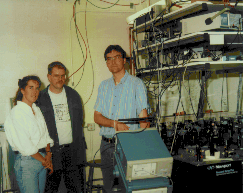David H. McIntyre
Laser Cooling & Laser Spectroscopy

|
 |
We built a laser cooled atomic rubidium beam as a matter-wave source for experiments in atom optics. Atoms in a thermal beam are slowed using Zeeman-tuned laser cooling [1] and are loaded into a two-dimensional magneto-optic trap or funnel which compresses the atoms and directs them into an intense, slow beam [2]. Atoms are ejected from the funnel with controllable velocities in the range of 3-10 m/s, with temperatures of order 0.5 mK. CCD images show atoms in the trap and downstream in a probe region. Picture One (24 Kb jpeg file) shows atoms expanding as they travel due to the finite temperature. Picture Two (46 Kb jpeg file) shows an orthogonal view of atoms seemingly at zero temperature, but the downstream probe acts also as a trap in one dimension to again compress the atoms. In this experiment, the rubidium cooling transition at 780 nm is excited with commercial diode lasers which are frequency stabilized using optical feedback from diffraction gratings [3].
In collaboration with C. E. Fairchild (OSU) and J. Cooper (JILA), we have studied diode laser noise and its effects on spectroscopic measurements. An atomic resonance converts laser frequency noise into intensity noise. We have carefully measured this resultant intensity noise and have compared it to a theoretical model of the laser as a phase- diffusing field. We find good agreement between theory and experiment [4].
We developed new techniques for laser diode frequency control. We developed a simple, digital frequency-offset locking system. We implemented and studied a novel means of optical feedback stabilization of a diode laser using saturated absorption in an optically thick atomic vapor [5].